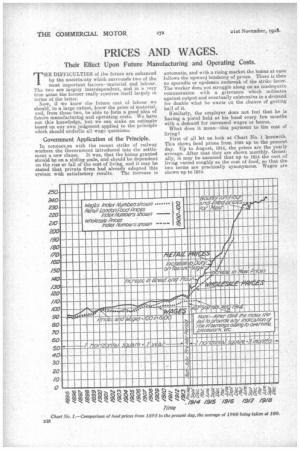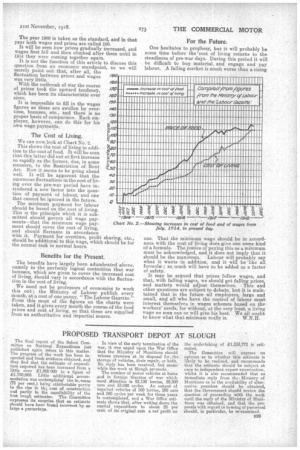PRICES AND WAGES.
Page 8

Page 9

If you've noticed an error in this article please click here to report it so we can fix it.
Their Effect Upon Future Manufacturing and Operating Costs.
THE DIFFICULTIES of the future are enhanced by the uncertainty which surrounds two of the most important faciors—material and labour. The two are largely interdependent, and in a very true sense the former really resolves itself largely in terms of the latter.
Now, if we know the future cost of labour we should, to a large extent, know the price of material, and, from these two, be able to form a good idea of future manufacturing and operating costs. We have not this knowledge, but we can make an estimate based on our own judgment applied to the principle which should underlie all wage questions.
Government Application of the Principle.
In connect.on with the recent strike of railway workers the Government introduced into the settlement a new clause. It was, that the bonus granted should be on a sliding scale, and should be dependent on the rise or fall of the cost of living, and it may be stated that private firms had already adopted this system with satisfactory results. The increase is automatic, and with a rising market the bonus at once follows the upward tendency of prices. There is then no sporadie or epidemic outbreak of the strike fever. The worker does not struggle along on an inadequate remuneration with a grievance which militates against output and eventually culminates in a demand for double what he wants on the chance of getting half of it.
$-anilarly, the employer does not feel that he is having a pistol held at his head every few months with a demand for increased wages or bonus.
What does it mean—this payment to the cost of living?
First of all let us look at Chart No. 1 herewith. This shows food prices from 1695 up to the present day. Up to August, 1914, the prices are the yeaily average. After that they are shown monthly. Generally, it may be assumed that up to 1914 the cost of living varied roughly as the cost of food, so that the two terms are practically synonymous. Wages are shown up to 1914. The year 1900 is taken as the standard, and in that year both wages and priees are called 100. It will be seen how prices gradually increased, and wages first fell and then climbed after them until in 1914 they were coming together again.
With the outbreak of war the course of prices took the upward tendency, which has been its characteristic ever since.
It is impossible to fill in the wages figures as these are swollen by overtime, bonuses, etc., and there is no proper basis of comparison. Each employer, however, can do this for his own wage payments.
The Cost of Living.
We can now, look at Chart No. 2.
This shows the cost of living in addition to the cost of food. It will be seen that this latter did not at first increase so rapidly as the former, due, in some measure, to the Restriction of Rent Act. Now it seems to be going ahead well. It will be apparent that the enormous fluctuations in the cost of living over the pre-war period have introduced a new factor into the question of payment of labour, and one that cannot be ignored in the future.
The minimum payment for labour should be based on the cost of living. This is the principle which it is submitted should govern all wage payments—that the minimum wage payment should cover the cost of living, and should fluctuate in accordance with it. Payment for overtime, profit sharing, etc., should be additional to this wage, which should be for the normal task in normal hours.
Benefits for the Present.
The benefits have largely been adumbrated above, namely in the perfectly logical contention that war bonuses, which are given to cover the increased cost of living, ihould vary in accordance with the fluctuation in the cost of living.
We need not be professors of economics to work this out ; the Ministry of Labour publish every month, at a cost of one penny, "The Labour Gazette.' Flom this most of the figures on the charts were taken, and it gives every month the course of the food prices and cost of living, BO that these are supplied from an authoritative and impartial source.
For the Future.
One hesitates to prophesy, but it will probably be some time before the 'cost of living returns to the steadiness of pre-war days. During this period it will be difficult to buy material, and engage and pay labour. A falling market is much worse than a rising one. That the minimum wage should be in accordance with the cost of living does give one some kind of a formula. The justice of paying this as a minimum must be acknowledged, and it does not imply that it should be the maximum. Labour will probably say what it wants in addition, and it will be' like all formulm ; so, much will have to be added as a factor of safety.
It may be argued that prices follow wages, and that, with falling wages, we should get falling prices, and matters would adjust themselves. This and other questions are subject to debate, but it is maintained that in the future all employers, large and small, and all who have the control of labour must interest themselves in wages schemes based on the workers' needs, for without, at the very least, a living wage no man can or will give his best. We all ought
to know what that minimum really is. W.N.H.






















